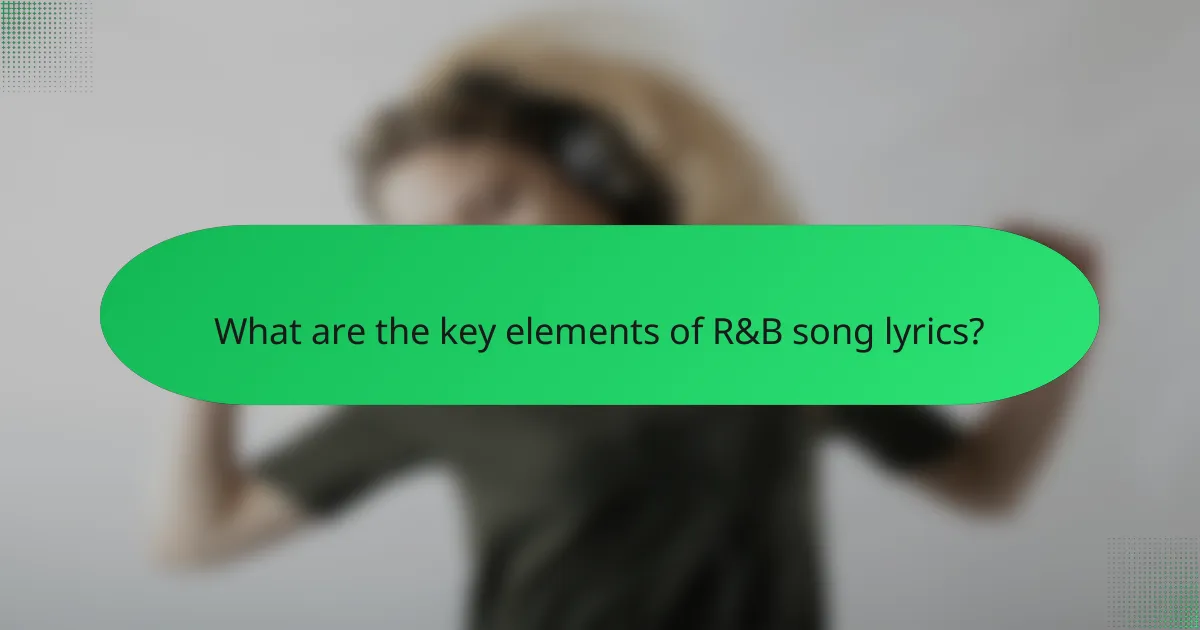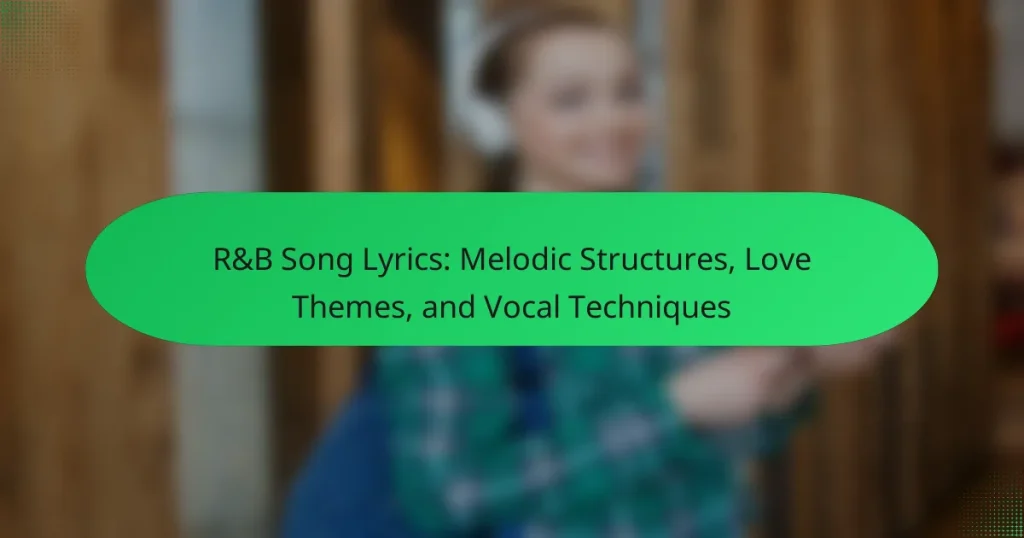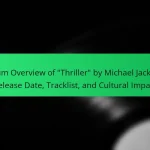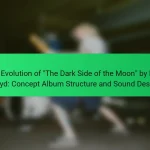R&B song lyrics are characterized by key elements such as emotional themes, storytelling, and melodic phrasing. Common emotional themes include love, heartbreak, and relationships, while storytelling often reflects personal experiences and feelings. Melodic phrasing enhances the delivery of lyrics, facilitating expressive vocal performances. Additionally, the use of repetition and hooks contributes to the memorability of the lines. The genre’s origins in blues and gospel music further enrich its lyrical depth and emotional resonance, collectively shaping the essence of R&B songwriting.

What are the key elements of R&B song lyrics?
Key elements of R&B song lyrics include emotional themes, storytelling, and melodic phrasing. Emotional themes often revolve around love, heartbreak, and relationships. Storytelling is prevalent, as lyrics frequently narrate personal experiences or feelings. Melodic phrasing enhances the lyrical delivery, allowing for expressive vocal performance. Additionally, R&B lyrics often utilize repetition and hooks to create memorable lines. The genre’s roots in blues and gospel influence its lyrical depth and emotional resonance. These elements collectively define the essence of R&B songwriting.
How do melodic structures influence R&B lyrics?
Melodic structures significantly influence R&B lyrics by shaping their emotional delivery and thematic content. The use of specific melodic patterns can evoke distinct feelings, allowing lyrics to resonate more deeply with listeners. For instance, ascending melodies often convey hope or joy, while descending melodies may express sadness or longing.
In R&B, the interplay between melody and lyrics creates a compelling narrative. Lyrics often reflect personal experiences, and the melody enhances their emotional weight. Research indicates that melodies with syncopation can add a playful or relaxed vibe, influencing the lyrical tone.
Additionally, the use of call-and-response patterns in melodies can mirror conversational elements in lyrics, reinforcing themes of connection and intimacy. This fusion of melodic structure and lyrical content is essential in R&B music, making it relatable and impactful.
What are the common melodic patterns found in R&B songs?
Common melodic patterns in R&B songs include smooth, flowing lines and repetitive motifs. These patterns often emphasize emotional expression. R&B melodies frequently utilize syncopation to create a laid-back feel. Additionally, many songs feature call-and-response elements, enhancing interaction. Harmonic progressions often follow the I-IV-V pattern, providing a familiar backdrop. Melodic embellishments, such as slides and bends, add character to vocal lines. Overall, these patterns contribute to the genre’s distinctive sound and emotional depth.
How do these melodic structures enhance the emotional impact of the lyrics?
Melodic structures enhance the emotional impact of lyrics by creating a musical backdrop that complements the words. These structures often utilize varying pitch, rhythm, and dynamics to evoke specific feelings. For example, ascending melodies can convey hope or joy, while descending melodies might express sadness or longing. The interplay between melody and lyrical content can intensify the listener’s emotional experience. Studies show that melodies can trigger emotional responses in the brain, reinforcing the message of the lyrics. In R&B, this connection is crucial, as artists often explore themes of love and heartbreak. The effectiveness of these melodic structures is evident in popular R&B songs, where emotional delivery is key to audience engagement.
What themes are prevalent in R&B lyrics?
Prevalent themes in R&B lyrics include love, heartbreak, and relationships. These themes often explore emotional connections and personal experiences. Love is frequently depicted in both its joyful and painful aspects. Heartbreak is a common subject, reflecting feelings of loss and longing. Relationships are portrayed with complexity, highlighting intimacy and conflict. Additionally, themes of empowerment and self-love have gained prominence in recent years. R&B artists often draw from personal narratives, making the lyrics relatable and impactful. This connection to personal experience enhances the emotional resonance of the music.
How do love themes manifest in R&B songs?
Love themes manifest in R&B songs through emotional lyrics, melodic expression, and vocal delivery. R&B lyrics often explore romantic relationships, heartbreak, and longing. Artists use metaphors and vivid imagery to convey deep feelings. Melodies in R&B are typically smooth and soulful, enhancing the emotional weight of the lyrics. Vocal techniques such as runs, ad-libs, and harmonies add layers to the expression of love. Historical examples include classics from artists like Marvin Gaye and contemporary works from artists like SZA. These elements collectively create a rich tapestry of love experiences in R&B music.
What are some examples of storytelling in R&B lyrics?
Examples of storytelling in R&B lyrics include narratives about love, heartbreak, and personal struggles. For instance, “Tears Dry on Their Own” by Amy Winehouse tells the story of unrequited love and emotional resilience. Another example is “I Will Always Love You” by Whitney Houston, which conveys a heartfelt farewell while expressing enduring love. “Superwoman” by Alicia Keys illustrates the challenges and triumphs of a woman’s journey. Additionally, “Dilemma” by Nelly featuring Kelly Rowland explores the complexities of a love triangle. Each of these songs uses vivid imagery and relatable themes to engage listeners and convey powerful emotions.
What vocal techniques are commonly used in R&B music?
R&B music commonly employs vocal techniques such as melisma, vocal runs, and falsetto. Melisma involves singing multiple notes on a single syllable, enhancing emotional expression. Vocal runs are quick sequences of notes that add flair and complexity to melodies. Falsetto allows singers to reach higher pitches, creating a soft and airy sound. These techniques are integral to R&B, showcasing vocal agility and emotional depth. Artists like Mariah Carey and Usher exemplify these techniques in their music, demonstrating their effectiveness in conveying love themes and melodic structures.
How do vocal runs and ad-libs contribute to R&B performance?
Vocal runs and ad-libs enhance R&B performance by adding emotional depth and showcasing vocal agility. Vocal runs involve intricate melodic variations that demonstrate a singer’s technical skill. They create a dynamic contrast within the song, capturing the listener’s attention. Ad-libs, on the other hand, provide spontaneous vocal embellishments that personalize the performance. These elements contribute to the overall expressiveness and individuality of the artist. Research indicates that vocal improvisation, such as ad-libs, can significantly engage audiences, making performances more memorable. This combination of runs and ad-libs is a hallmark of R&B, reflecting its roots in African American musical traditions.
What role does vocal emotion play in conveying lyrical themes?
Vocal emotion plays a crucial role in conveying lyrical themes. It enhances the listener’s connection to the song’s message. Emotional delivery can amplify the intended feelings behind the lyrics. For example, a heartfelt performance can evoke empathy and resonance. Research indicates that vocal expression significantly influences emotional perception in music. Studies show that variations in pitch and tone can alter the listener’s emotional response. In R&B, artists often use vocal techniques to express love, longing, and pain. This emotional depth helps to reinforce the lyrical narrative, making the themes more impactful.
How do R&B lyrics connect to broader musical trends?
R&B lyrics connect to broader musical trends through their thematic exploration and stylistic evolution. They often reflect contemporary social issues, personal experiences, and emotional depth. This connection is evident in the integration of hip-hop influences, which has transformed R&B into a more versatile genre. For instance, artists like Drake and Beyoncé blend rap elements with traditional R&B, showcasing a fusion of styles. Additionally, R&B lyrics frequently address themes of love, heartbreak, and empowerment, resonating with listeners across various genres. The genre’s adaptability allows it to stay relevant within the ever-changing musical landscape. Historical shifts, such as the rise of neo-soul in the late 1990s, illustrate how R&B continuously evolves while maintaining its core emotional resonance.
What is the relationship between R&B song lyrics and cultural movements?
R&B song lyrics often reflect and influence cultural movements. These lyrics address social issues, personal experiences, and collective emotions. For example, during the Civil Rights Movement, R&B songs highlighted themes of struggle and resilience. Artists like Sam Cooke and Aretha Franklin used their music to inspire change and unity. The lyrics serve as a voice for marginalized communities, expressing their hopes and frustrations. Additionally, contemporary R&B continues to engage with topics like identity, love, and empowerment. This ongoing dialogue between R&B lyrics and cultural movements shapes both the genre and society at large.
What are the best practices for writing R&B song lyrics?
The best practices for writing R&B song lyrics include focusing on emotional authenticity and storytelling. R&B lyrics often revolve around themes of love, heartbreak, and relationships. Using vivid imagery can enhance the emotional impact of the lyrics. Incorporating personal experiences makes the song relatable to listeners. A strong hook is essential for capturing attention and creating memorability. Utilizing rhyme schemes and rhythmic patterns contributes to the song’s flow and musicality. Collaborating with other songwriters can bring fresh perspectives and ideas. Listening to successful R&B songs can provide insights into effective lyric writing techniques.
How can aspiring songwriters develop their melodic structures?
Aspiring songwriters can develop their melodic structures by studying existing songs and identifying patterns. Analyzing popular R&B tracks reveals common chord progressions and melodic motifs. Practicing scales and intervals helps in creating unique melodies. Experimenting with different rhythms can add variety to melodic lines. Collaborating with other musicians can provide fresh perspectives on melody development. Utilizing songwriting software can assist in arranging and refining melodies. Regularly recording and reviewing compositions aids in identifying effective melodic elements. Engaging in workshops or classes can enhance skills through guided practice and feedback.
What tips can enhance the emotional depth of R&B lyrics?
To enhance the emotional depth of R&B lyrics, incorporate vivid imagery and personal experiences. Vivid imagery allows listeners to visualize emotions and situations. Personal experiences create authenticity and relatability. Use metaphor and simile to express complex feelings in accessible ways. This technique deepens emotional connection. Additionally, focus on storytelling to convey a narrative arc. A strong narrative can evoke empathy and engagement. Experiment with vocal delivery to match lyrical emotion. The delivery can amplify the intended feeling. These strategies are supported by successful R&B artists who utilize them to resonate with audiences.
R&B song lyrics are characterized by emotional themes, storytelling, and melodic phrasing, focusing primarily on love, heartbreak, and relationships. This article explores how melodic structures influence the emotional delivery of lyrics, highlighting common patterns such as syncopation and call-and-response elements. It also examines the role of vocal techniques, including melisma and vocal runs, in enhancing the expressiveness of R&B performances. Additionally, the article discusses prevalent themes in R&B, the connection to cultural movements, and best practices for writing impactful lyrics.


